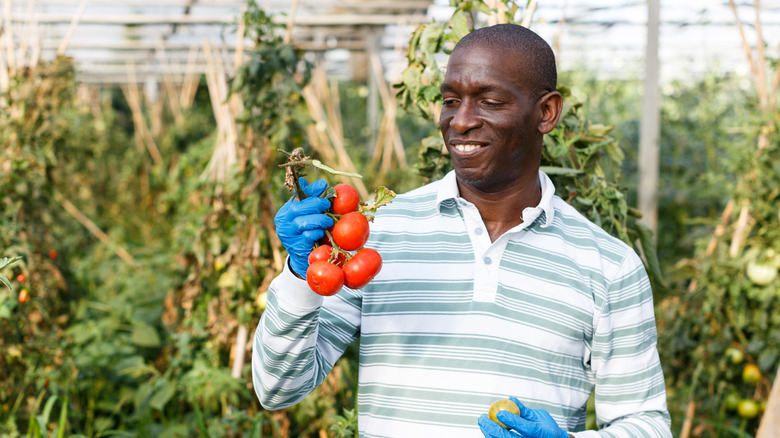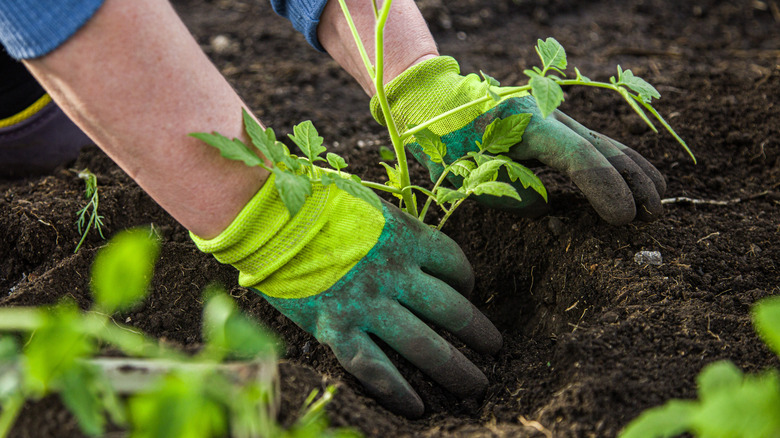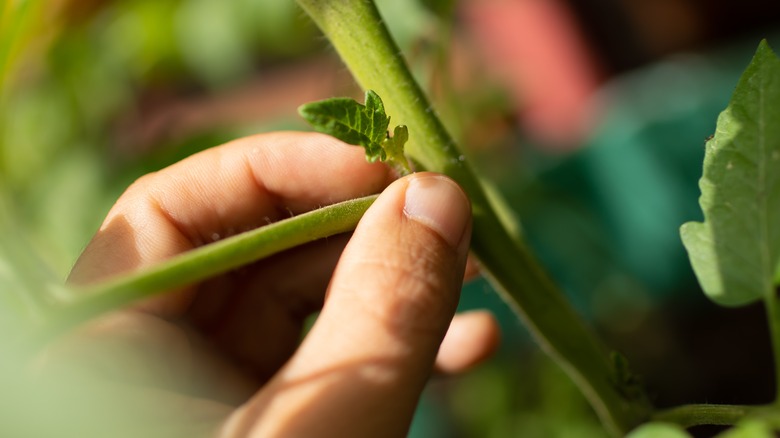How To Prune Your Tomatoes
Pruning your garden is a large task that may seem difficult at first, but after all the hard work you put into starting plants, you'll want to finish out the growing season strong; it's an important step in growing most edible and many non-edible plants. Pruning makes sure that your tomato plants have the optimal amount of sunlight, airflow, and energy to produce several large and juicy tomatoes come harvest time. Cutting away energy-draining foliage and suckers (those little shoots that form from the side of the main stems) can help you grow high-yielding plants at a manageable size with fewer pests and diseases wreaking havoc.
The first thing to note about tomatoes is that there are two types: determinate and indeterminate. Determinate varieties only grow until they reach a particular size, while indeterminate varieties continue to grow and fruit until the end of the growing season. All you need to keep in mind right now is that the indeterminant types are the ones that need the most pruning. In this short guide, we'll cover how and when to prune your tomato plants so you can get the most out of them.
When to prune your tomatoes
Pruning isn't usually completed on a specific date. The task has much more leeway compared to when you should start seeds or harden off young plants. In fact, you may need to prune your tomatoes a few different times throughout the season depending on which type you're growing. Indeterminate plants even need pruning at the time of planting. If you bought a young tomato seedling from the store, you'll likely need to cut away the lowest leaves to allow you to bury it deeper into the soil. It's also a good idea to prune any flowers that have formed to redirect energy to the leaves while it's still early in the growth cycle.
Mid-season is when you'll really want to get down to business. At this point, your tomato plants, determinate or indeterminate, will be ready for a trim. You may have to remove more flowers and nearly all of the leafy suckers. Smaller plants will need help with redirecting their energy so they can provide you with even more healthy fruit as they grow into the late season, however, you can limit the amount of pruning you do as time goes on. You may need to speed up the time it takes for fruits to ripen as the season comes to a close. To do so, prune each main stem a month in advance of the first expected frost. This pushes the sugars to the remaining fruit causing them to ripen faster.
So long, suckers
In a small home garden, suckers are mostly useless because they only take away from the energy that is necessary for good tomato growth. When pruning an indeterminate tomato plant, you should be removing most of these suckers so that the main stems of the plant have the best chance to thrive. The suckers that appear later in the season are typically weak and give way to less-tasty fruit, so you don't want to give them the opportunity to mature.
As you remove these extra stems and leaves, you can either pinch them off with your fingers or snip them with sterile scissors. Most young suckers can be pinched off easily which is good because this method is the least damaging to the plant. However, if you've let a sucker mature it will likely be too strong to pinch off. Use your sterilized scissors instead and snip off the sucker as close to the main stem as possible to reduce the chances of infection. In addition to these small growths, give your determinant and indeterminate tomato plants a haircut from their base, trimming off older and yellowing leaves that are also stealing energy from healthy fruiting branches.


